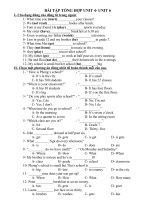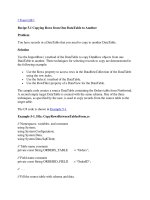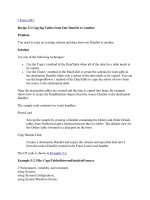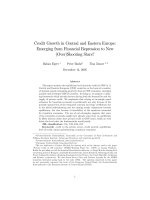deutsche borse group - from trading floor to virtual marketplace
Bạn đang xem bản rút gọn của tài liệu. Xem và tải ngay bản đầy đủ của tài liệu tại đây (3.9 MB, 19 trang )
From Trading Floor
to Virtual Marketplace
Published by
Deutsche Börse Group
60485 Frankfurt/Main
Germany
July 2002
Order number: 1010-1404
All rights reserved.
Reproduction in whole or in part only with
the express consent of the publisher
®
Registered trademark of Deutsche Börse AG
STOXX
SM
Registered trademark (service mark) of STOXX
Ltd./Switzerland
Deutsche Börse Group
Would you like to receive additional information?
Please call our publications service. Most brochures can be
delivered free of charge.
Phone +49-(0)69-21 01-15 10
Fax +49-(0)69-2101-15 11
Deutsche Börse Group
What is a stock exchange anyway?
How does stock trading work?
How does Xetra’s electronic trading work?
How do securities change hands?
What’s the deal?
What’s the DAX doing?
Know futures?
The Deutsche Börse Group
Deutsche Börse on the internet
Further Information
1
3
7
11
15
19
23
27
30
31
32
Xetra screen
The Xetra screen displays all the information
required to conduct electronic trading in stocks
and shares. At the click of a mouse, traders can
select a security and enter their buy or sell order
in the window provided along with additional
details such as volume, price limit and validity
constraints. In continuous trading, Xetra initiates
an automatic plausibility check on every buy and
sell order. If a matching order exists, the trans-
action is executed immediately and the participant
receives simultaneous confirmation. In so-called
auctions, Xetra calculates the price for all out-
standing orders which would yield the highest
turnover. In addition, Designated Sponsors (banks
that “nurture” individual shares) enter buy and
sell offers into the system. This also gives small
investors a better chance of placing a successful
order at any one time.
Stock symbol
National securities identification number
Buy volume
Buy limit
Sell limit
Sell volume
Norway 2
Finland 2
Sweden 3
Ireland 5
UK 48
Spain 6
Italy 7
Switzerland 14
Austria 23
France 16
Belgium 5
Luxembourg 3
Netherlands 23
Germany 198
Greece 3
Hongkong 1
Host
Access point
Member
359 members in 16 countries
Europewide trading
Finland 12
Sweden 4
Denmark 2
Ireland 6
UK 71
Portugal 1
Gibraltar 2
Spain 15
Italy 11
Switzerland 39
Austria 5
France 30
Belgium 4
Netherlands 29
Germany 125
(Frankfurt)
Greece 4
Australia 1
USA 63
Host
Access point
Member
424 members in 18 countries
Worldwide trading
01
Deutsche Börse Group
■
is one of the leading international exchange organizations
■
offers the three core functions trading, settlement and
information products
■
operates Xetra
®
, the world’s most powerful electronic trading
system for the stock market
■
organizes the world’s largest derivatives market via its
subsidiary Eurex
■
owns Clearstream, Europe’s leading securities settlement
organization
■
makes market activity transparent with information products
such as the DAX
®
and numerous indices and prices
■
develops and operates complex technology solutions as
owner of IT service provider Deutsche Börse Systems
and entory
■
initiates the electronic trading of standardized goods such
as commodities, industrial and consumer goods via its
subsidiary xlaunch
What is a stock exchange anyway?
03
A stock exchange is a market-
place where buyers and sellers
come together to trade. But it
is not the usual type of market-
place. Take a look around: you
won’t find a trace of the goods
that are being so busily traded.
And if electronic trading contin-
ues to grow at the current rate,
soon there won’t be any traders
left on the floor, either.
04
1500–1600
More than a German exchange
Deutsche Börse organizes securities markets, and has done so
for the past 400 years. Exchanges are one of the most ancient
forms of trade – but also one of the most modern. The days
when Deutsche Börse could be described as a mere market-
place or even a stock exchange for Germany are long gone.
These days, Deutsche Börse is a transaction service provider,
smoothing the way for investors and companies to the global
capital markets with high-performance technology.
Deutsche Börse covers the entire spectrum of products and ser-
vices that are part and parcel of exchange trading: from securities
and derivatives trading through the settlement of transactions
and provision of market information right up to the development
and operation of electronic trading systems.
05
1585
Opening of the Frankfurt Stock Exchange
In Xetra
®
, Deutsche Börse has an electronic trading platform of-
fering outstanding efficiency and performance. Eurex, a Deutsche
Börse subsidiary, has risen to become the world’s leading futures
and options exchange in the shortest periode of time. Deutsche
Börse also owns Clearstream International, the largest European
organization for the settlement of securities transactions. Subsi-
diaries Deutsche Börse Systems and entory build and operate
the trading systems, as well as Deutsche Börse’s worldwide
participant network.
Deutsche Börse has young, international staff with above-average
education and skills. Reliability, speed, innovation and global
thinking are the company’s hallmarks.
07
How does stock trading work?
For centuries, nothing changed
in the way the stock exchange
conducted business: All par-
ticipants came together in an
impressive building to trade
by open outcry. In the past
15 years, however, electronic
trading systems which do not
depend on a specific location
have revolutionized trading
on the stock exchange; trad-
ing on the floor, and the floor
itself, are losing significance
worldwide.
08
1625
First official quotations sheet
1600–1700
09
“Daimler 4 Geld, 5 Brief!” – “An dich!”*
Deutsche Börse provides the infrastructure for the trading floor,
but it’s the traders and brokers that actually do the deals. Traders
are employed by banks and other financial institutions to buy
and sell securities on behalf of their clients, whereas unofficial
brokers trade on their own account.
Both of these denizens of the financial bestiary typically pace
the trading floor talking rapidly into mobile phones. By contrast,
the official brokers sit behind the red “barriers”, collecting the
orders and calculating the official prices. The price is deemed
to be “official” because the official broker’s office is a public
one, and he or she is appointed by the state of Hesse.
The terminology still used dates back to former times when
most deals were done by calling out orders. “Geld” (bid) means
“I want to buy”, and “Brief” (ask) means “I want to sell”. The
preceding figure indicates the price offered. Today, even trading
on the floor would be unthinkable without the computer. Via
Xontro, the electronic order routing system, orders are sent
directly from the bank to the stock exchange and into the offi-
cial brokers‘ order book. However, the majority of orders no
longer reach the floor, but are traded electronically on Xetra.
*This is what you might hear brokers on the trading floor in Frankfurt
call out to each other; the literal translation: “Daimler 4 bid, 5 ask!”
– “It’s yours!”
11
With the introduction of the
electronic trading system
Xetra
®
in November 1997,
Deutsche Börse embarked on
a new era in exchange history:
stocks and shares moved from
the trading floor to the com-
puter screen, the physical
presence on the floor is no
longer a prerequisite for par-
ticipation in trading.
How does Xetra’s
electronic trading work?
1700–1750
12
60 orders per second
Speed, transparency and cost-effectiveness are the decisive
benefits offered by Xetra. Deutsche Börse’s electronic trading
system processes up to 60 orders per second at extremely low
cost, regardless of the trader’s location. Furthermore, the Xetra
order book showing the buy and sell offers for each tradable
security can be viewed, thus making the market transparent
and fair for all participants.
Xetra is currently the most efficient and flexible system infra-
structure worldwide. On its first day of operation, in 1997,
221 market participants in seven countries began trading in the
system and closed a total of 4,934 trades. Today, more than
400 market participants in 17 countries are connected to the
system. In peak times, Xetra processes up to 200,000 trades
per day.
13
Xetra has increasingly replaced broker-supported stock trading
on the floor. Today, some 95 percent of DAX
®
stocks and over
86 percent of all German shares entered into the order book are
traded on the system. Deutsche Börse has been calculating all
indices on the basis of Xetra prices since June 1999. Private
investors also profit from this new technology: intraday trading
and real-time prices would be impossible without Xetra. The
system was developed by Deutsche Börse Systems AG.
Information technology is the key to success in the competition
among the international financial marketplaces. Today, success-
ful exchanges are much more than simply marketplaces: they
are technology service providers. Through the acquisition of
entory AG, a systems solutions supplier specializing in the finan-
cial sector, Deutsche Börse increased its core competencies in
information technology and has advanced to become a leading
international full-service provider for the development and oper-
ation of electronic trading systems. Deutsche Börse Systems
currently operates 18 exchanges worldwide.
15
Whether you deal through
your bank by phone or place
your order online, a complex
chain of services is triggered
every time you buy or sell
shares. The transaction itself
– whether via Xetra or on the
floor – is just the beginning.
How do securities
change hands?
1750–1800
16
Clearing and settlement of securities
The trading floor certainly presents a captivating show to the
spectator. But like any good performance, the exchange’s suc-
cess is largely due to the people behind the scenes. Only one
fifth of value added can be attributed to actual trading; the re-
mainder is generated by a far more complicated process: the
settlement of transactions. Once trading on the floor is com-
pleted, the individual deals have to be entered into the books
and processed. Further steps involve crediting the amount to
the client’s account and the central safe-keeping of securities.
The terms used by the exchange to describe these procedures
are clearing, settlement and custody.
17
High-performance stock exchanges require high-performance
settlement organizations. To this purpose Deutsche Börse took
over Clearstream International completely in July 2002. It had
formerly owned a 50 percent stake in the Luxembourg-based
clearinghouse. Some €7.5 trillion worth of shares, bonds and
funds are in Clearstream’s custody. However, most securities
are no longer physically stored and transported; instead, only
the information is booked and secured in electronic storage
media.
Apart from the core businesses of securities settlement and
custody, Clearstream also offers services covering all aspects
of securities lending. To this end, Clearstream Banking acts as
a neutral intermediary between lender and borrower and also
takes over the administration of the collateral deposited. Secu-
rities lending permits market participants to raise the yields of
their portfolios and to minimize risks.
19
What’s the deal?
The stocks and shares of more
than 5,700 companies are
listed on the FWB
®
Frankfurter
Wertpapierbörse (the Frankfurt
Stock Exchange). Since the
year 2000, some 170 com-
panies went public. In addi-
tion to stocks and shares,
trade in fixed-income securities
(bonds, mortgage bonds and
debentures) and warrants is
also significant. Around 6,800
fixed-income securities and
some 23,000 warrants are
currently traded on the
Frankfurt Stock Exchange.
20
Made to measure capital markets
By providing access to the various market segments, Deutsche Börse
offers companies tailor-made conditions for raising capital. The seg-
ments also make it easier for investors to find their way around the
capital market, allowing them to target their investments to their
individual risk/return profile. Securities undergo a rigorous selection
procedure before they can be listed in one of the six segments.
Official Trading
Around 530 shares are listed in the Official Trading segment. These
include the 30 standard stocks (so-called “blue-chips”) that make
up the DAX
®
index. Official Trading is the segment with the highest
turnover on the Frankfurt Stock Exchange. The admission criteria
are strict: for example, the issuing companies must have been in
business for at least three years and have published regular finan-
cial statements during this period.
Regulated Market
Over 130 shares are admitted to the Regulated Market. The admis-
sion criteria are less strict than for Official Trading. Medium-sized
companies typically use the Regulated Market as their initial segment
when going public.
Regulated Unofficial Market
There are few conditions for admission to the Regulated Unofficial
Market. Approximately 4,800 stocks (mainly foreign companies) and
warrants are traded on this market. Companies meeting particularly
strict requirements (e.g. publication of quarterly reports, using the
IAS or US GAAP accounting standards, and disclosing directors’ stock-
holdings) can be admitted to the Neuer Markt
®
or SMAX
®
.
1820
First stock issued in Frankfurt
1800–1900
21
1896
German Stock Exchange Law is passed
Neuer Markt
Established in 1997, the Neuer Markt has paved the way for
fledgling companies to the capital markets. This market segment
is attractive for investors who are interested in companies pro-
viding innovative products and services and who are willing to
accept a higher calculated risk in return for higher return.
SMAX
Medium-sized companies whose shares are traded on the Official
Trading or the Regulated Market segments can take advantage
of a forum that distinguishes them from the mass of second-
line stocks. SMAX was launched in 1999.
XTF Exchange Traded Funds
®
In XTF, unlike in classical fund business, fund shares can be
traded continuously like shares without an offering premium. You
can choose between index funds, with which you can participate
in the development of e.g. the DAX or the Euro STOXX
SM
50,
or actively managed funds; whose performance strives to exceed
that of an index. The XTF segment began trading in April 2000.
23
What’s the DAX doing?
The DAX
®
is the benchmark
for the German stock market
and an important mood ba-
rometer for the German eco-
nomy as a whole. The 30
standard stocks which go to
make up the DAX constitute
80 percent of the turnover on
the Frankfurt Stock Exchange
and around 75 percent of total
stock turnover on the German
market. Since the DAX be-
came popular with television
broadcasters and a regular
closing feature of the main
evening news, it has entered
the collective consciousness.
These days, it’s as normal to
discuss the DAX as it is to
talk about the weather or the
football results.
24
Information generates trading
Successful investors in the capital markets require up-to-the-
minute information from a reliable source. Using market prices,
they can get a picture of a company’s economic health, or
equally the health of a business sector or an entire country.
Deutsche Börse ensures accuracy by collecting financial data
where they are generated – on the electronic platforms of its
own trading systems. Using prices, indices and statistics,
Deutsche Börse renders transparent what happens on the
markets.
The indices provide important information about Deutsche Börse’s
various trading segments. Trends on the German market are illus-
trated by the DAX
®
, MDAX
®
and NEMAX 50
®
. On a European
level Deutsche Börse is the partner of STOXX Ltd.; their indices
are among the leading European indices.
Deutsche Börse calculates and distributes a total of about 1,200
indices, the majority of which are not for stocks, however, but
for German and other European government bonds.
1900–1950
25
DAX
The German stock index (Deutscher Aktienindex). Comprises the 30
largest German stocks in Official Trading at the Frankfurt Stock Exchange
in terms of market capitalization and turnover.
MDAX
Mid-cap DAX. Comprises the 70 German stocks ranking directly below
the top 30 DAX companies in terms of market capitalization and turn-
over.
SDAX
Small-cap DAX. Comprises the 100 largest stocks with the highest mar-
ket capitalization and turnover within the SMAX
®
– a quality segment for
companies with lower market capitalization.
NEMAX 50
Neuer Markt Index. Comprises the 50 largest stocks with the highest
market capitalization and turnover in the Neuer Markt
®
segment. The
NEMAX All Share index includes all Neuer Markt stocks.
Dow Jones Euro STOXX 50
European blue-chip index, comprising 50 blue-chip shares from the
EU member countries. Criteria for inclusion in this index are sector
and market capitalization.
Admission to an index
Market capitalization, exchange turnover and free float (the share of
freely tradable stocks) are the decisive criteria for evaluating a company
regarding its admission to an index or when the composition of an index
is reviewed. The decision is taken according to the statutes of a set of
transparent and comprehensible regulations.
February 23, 1945
Closure of the stock exchange
27
Know futures?
Who has never dreamt of
seeing into the future? Due to
its distinctive relationship to
the future, the stock exchange
has developed instruments
designed to make tomorrow
more manageable. Futures
and options give the right
or oblige to buy or sell under-
lying securities on a fixed date
at a predetermined price.
This allows investors to pro-
tect their investments against
price fluctuations. Speculation
in futures and options tempts
with prospects of high returns
for low investments, but cau-
tion is recommended. You can
just as easily lose all your
money!
28
Eurex, the futures and options exchange, is a subsidiary of
Deutsche Börse and SWX Swiss Exchange. It was formed in 1998
through the merger of DTB (the German derivatives exchange)
and the Swiss Soffex. In 2001, some 674 million contracts were
traded on Eurex. This was an increase of almost 50 percent on
the previous year’s figure.
In individual products – such as the Bund future or the Bobl
future – Eurex now enjoys a market share of over 90 percent,
making it by far the world’s largest market for the trading and
settlement of futures and options on shares and share indices,
as well as on the capital market.
What makes Eurex so successful? Eurex banked on electronic
trading combined with an international network right from
the start. Today, some 425 participants in 17 countries are
connected to the Eurex
®
trading system. Eurex is currently in
the process of connecting members in the Far East, so that it
is only a matter of time before Eurex can boast a presence in
markets spanning three time zones: Europe, America and the
Pacific Rim. The Eurex trading system was developed by
Deutsche Börse Systems AG.
September 14, 1945
Reopening of the
Frankfurt Stock
Exchange
1950–2000
1958
The first foreign stocks are listed
Eurex: The world’s leading market
for futures contracts
29
July 1, 1988
Launch of the DAX
®
November 28, 1997
Xetra
®
goes online
March 10, 1997
Launch of Neuer Markt
®
September 28,1998
Founding of Eurex
Derivatives market
Market for futures and options. In contrast to trading in shares and bonds,
transactions in derivatives trading, such as delivery, acceptance and pay-
ment, are not completed until an agreed point in the future has been
reached.
Option
Financial instrument which gives the buyer the right to buy or sell an
underlying (for example a share) at a certain time and at a price deter-
mined in advance.
Future
Financial instrument by which the buyer is obliged to buy or sell an
underlying (for example a share) at a certain time and at a price deter-
mined in advance.
Call
Buy option with which the buyer can profit disproportionately from
rising prices.
Put
Sell option with which the buyer can hedge against the risk of falling
prices.
Underlying
Instruments on which futures and options contracts are based such as
equities, bonds, indices, currencies or commodities.
The Deutsche Börse Group comprises Deutsche Börse AG
and its subsidiaries Clearstream International, Deutsche Börse
Systems AG, entory AG and xlaunch AG. Deutsche Börse AG
operates the FWB
®
Frankfurt Stock Exchange and has an
80 percent stake in the derivatives exchange Eurex.
Deutsche Börse AG itself has been listed since February 5, 2001.
With a market capitalization of around €5 billion (June 1, 2002),
the company is one of the largest MDAX stocks and by far the
most highly valued exchange organization in the world. Around
50 percent of its shares are owned by institutional investors.
The largest individual stakeholders are Deutsche Bank, Allianz
and the other regional German exchanges.
30
The Deutsche Börse Group
2000-2002
January 1, 2000
Clearstream International founded
You will find information on the capital markets on Deutsche
Börse’s homepage www.deutsche-boerse.com. Here you can
access the latest exchange news, prices, indices as well as infor-
mation on recent admissions to the stock exchange. There are
links to all Deutsche Börse Group business segments, as well as
to several companies whose stocks are listed on the exchange.
Individual stock quotes can also be called up in separate fields –
so that you always know how your stocks are doing. Two naviga-
tion bars provide access to several thousand further pages, e.g.
you will find the basics of the stock market in the menu item:
Services/Know-how.
With an average of 650,000 hits per day, Deutsche Börse’s web-
site is one of the most successful Internet services in the German
financial sector.
31
www.deutsche-boerse.com
December 17, 2001
Acquisition of entory AG
Summer 2000
Deutsche Börse Group moves to
new premises, the “Neue Börse”
July 12, 2002
Acquisition of
Clearstream International
February 5, 2001
IPO of Deutsche Börse AG
In addition to visits to the trading floor and the information on
the web, Deutsche Börse also offers brochures and booklets on
a range of topics.
The Visitors Gallery
We look forward to seeing you
■
The basics of exchange trading are revealed three times a day,
at 10:00 a.m., 11:00 a.m. and 12 noon (please book before-
hand)
■
Looking onto the trading floor of the Frankfurt Stock Exchange,
the Visitors Gallery is open to visitors from 10:30 a.m.
to 6 p.m. by appointment only (don’t forget to bring your
passport)
■
Information phones explain what is happening on the floor
■
During your visit we’ll call up the latest share prices and
charts upon request
For bookings call:
Phone +49-(0)69-21 01-15 15
(daily from 9:00 a.m. to 5:00 p.m.)
Fax +49-(0)69-21 01-15 11
32
Want to find out more about
the Börse?









